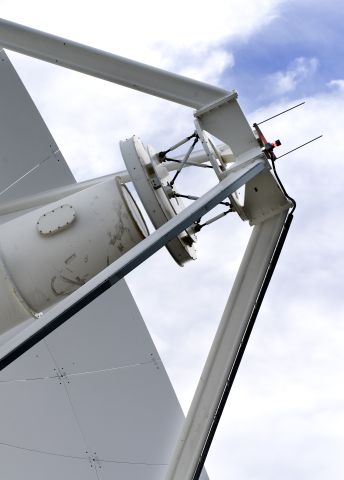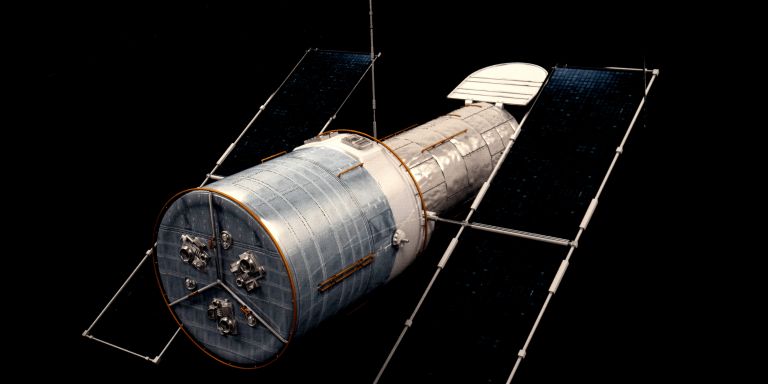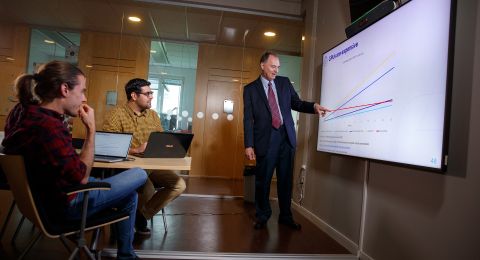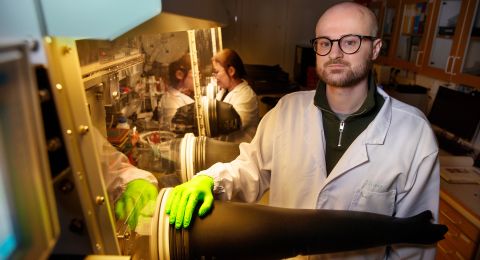
Project Grant 2020
The Origin and Fate of Dust in Our Universe
Principal investigator:
Professor Kirsten Kraiberg Knudsen
Co-investigators:
Chalmers University of Technology
Wouter Vlemmings
Susanne Aalto
University of Gothenburg
Gunnar Nyman
Institution:
Chalmers University of Technology
Grant in SEK:
SEK 27.7 million over five years
A word like dust might cause some people to think about vacuum cleaning the house, but it has quite different connotations for an astronomer. Cosmic dust grains are vital to all life in the Universe. Kirsten Kraiberg Knudsen, astronomer at Chalmers University of Technology, elaborates:
“Without these minute particles we would not exist. They are essential to virtually every process in the Universe.”
Knudsen is in charge of a project exploring dust in the Universe with the help of researchers at Chalmers and the University of Gothenburg. Dust is central to chemical processes, and many molecules in the cosmos form on the surface of dust particles. Those involved in the project want to gain a better understanding of how dust forms, how it grows and survives, and how it is destroyed in various cosmic environments due to collisions or radiation, for example.
Cosmic dust originates from old stars. Wouter Vlemmings, one of the researchers, explains:
“In particular, dust particles are generated around dying stars. The particles often consist of carbon atoms, but around some stars there are also silicon atoms or other metals such as magnesium and iron. But it’s not easy to clearly distinguish between highly complex molecules and what we end up calling dust.”
Dust particles from stars can grow and change as new substances adhere to their surface when molecules collide or clump together. Different types of dust also form in varying cosmic environments, e.g. in cold regions, in the vicinity of supermassive black holes or in the early Universe.
“The simple question of what dust is made up of is actually quite hard to answer,” says Vlemmings.
The researchers hope the project will enable them to piece together a more complete picture of how dust has been dispersed in the Universe in different phases. But it is a challenge to interpret data from individual measures of molecules, for example, so as to understand how cosmic dust behaves as different events unfold. A stellar wind can carry cosmic dust into the space between stars, often at fairly high velocity. In some cases parts of the dust can be involved in the creation of supernovas – massive stars that explode.
“Local results are sometimes surprising, and we need to use many and varied observation methods to gain a better understanding.”
Enhanced understanding from theoretical models
The researchers are combining new observations with advanced theory. Gunnar Nyman at the University of Gothenburg is contributing theoretical models in the field of physical chemistry.
“As a chemist I’m studying small-scale processes, for instance what happens when a molecule forms, how it behaves and when it disintegrates.”
The idea is to fine-tune calculations that describe the dust particles at molecular level. Many parameters must be considered, including temperature, which can fluctuate dramatically between different cosmic environments, impacting the dispersal of dust particles.
“Temperature is a typical example of a parameter that we can calculate for different conditions in the Universe. Hopefully, this project will enable us to obtain more accurate values that will improve the models we use to understand cosmic dust.”
Invisible galaxies
The researchers also want to learn more about how cosmic dust affects our view of the Universe. Dust particles are able to absorb light, thereby rendering objects in space invisible.
“We know that dust has a major impact by obscuring light from the source we want to observe. This can have major implications for the way we interpret scientific results,” Knudsen explains.
For example, until recently certain neighboring galaxies were invisible due to large quantities of cosmic dust. They were discovered just a few years ago. Susanne Aalto explains:
“Galaxies are hosts to dusty dark hearts that we cannot detect in normal light. It was an astonishing discovery at first since they’ve been hidden yet are so close to us. Not even X-ray radiation is capable of penetrating their multiple layers of dust.”
Growing supermassive black holes lie at the center of these galaxies. This came as a surprise to astronomers.
“They seem to conceal exceptional growth of black holes, which we don’t expect in the nearby Universe. We associate such galaxies with a much earlier phase of the Universe.”
The researchers want to find out more about this remarkable phenomenon, in which cosmic dust obviously plays a key role.
“I hope the project will reveal more about what the dust does, what properties it has, where it comes from, how it evolves and grows, and the final fate of galaxies,” Aalto adds.
The project grant from Knut and Alice Wallenberg Foundation has been essential to this joint effort.
“We have a chance to open our senses and find inspiration from other research fields,” says Vlemmings.
“This initiative enables us to establish a joint platform. We will also be able to raise the profile of this research topic, generating interest among our fellow researchers around the world,” says Knudsen.
Text Nils Johan Tjärnlund
Translation Maxwell Arding
Photo Johan Wingborg





